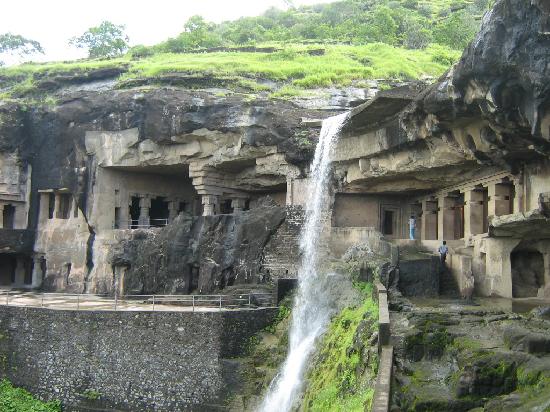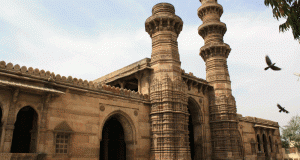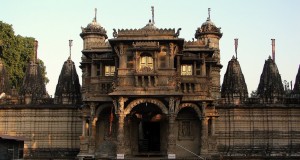This useful tour covers not just Ellora, but a number of interesting spots in and around Aurangabad. If you decide you need more time at Ellora, stay overnight at the Hotel Kailash (tel 43, 46), with simple rooms Rs100, close to the caves.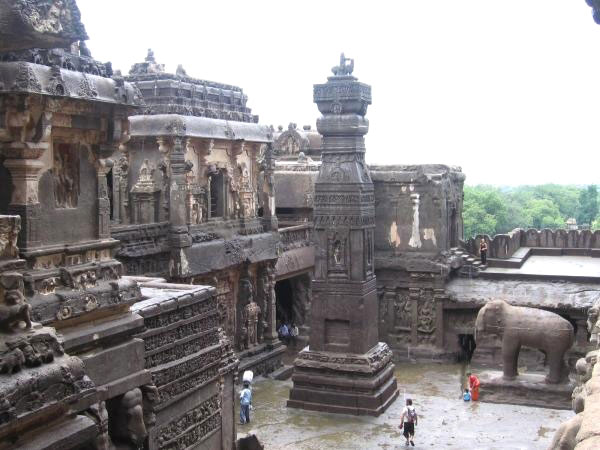 This has single/double rooms and good food in its attached restaurant.
This has single/double rooms and good food in its attached restaurant.
First stop on this tour, halfway to Ellora, is the remarkable hilltop fortress of Daulatabad. Built by Bhilama Raja of the Yadava dynasty in AD 1187 and named Devagiri or ‘hill of the gods’, it later gained fame as the place selected by mad Mohammed Tughlaq (the unhinged Delhi Sultan) as his new capital. He force-marzthed all his subjects here in AD 1327, renamed the fort Daulatabad or ‘City of Fortune’, and then—just 17 years later—marched them all the way back to Delhi again. It was 1 a long, long march (1100 km: 690 miles) and a good many of them didn’t make it.
The only raised point in an otherwise flat wilderness, Daulatabad fort is perched n top of a 200-m high pyramidal hill. Surrounded by 6 km (3 3/4 miles) of thick walls, equipped with massive spiked gates (to deter elephant charges), dead-end ambush . eys, overhead channels (for depositing boiling oil on invaders), steep, gravelled slideways and, once, a crocodile-infested moat, Mohammed’s new capital really was masterpiece of security. The only trouble was, the water-supply gave out during a gse, and thien (a every Indian device) the invading forces bribed Sultan’s guards let them in by the front gate.
The tour round the fort is fascinating, but you’ll need a flashlight. Just inside the eltrance gate is the huge Chand Minar pillar. Built in 1435 as a Victory Tower, it soars at height ofo 60 m and is only surpased by Delhi’s 72-m Qutb Minar.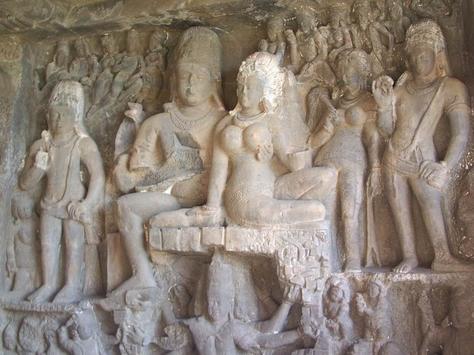 It faces onto a small mosque erected over an old Jain temple. Across the moat (now a dry gully), , you begin a half-hour climb up to the fort. On the ascent look out for the Chini Mahal, the (blue-tiled palace where Golconda’s last king spent his final 13 years imprisoned, and the massive 6-m cannon engraved with Aurangzeb’s name and cast from five lifferent metals. Near the top there’s the pitch-black, spiralling tunnel used to Inleash burning coals on invaders. This is where you need the flashlight. Enjoy fine mews from the bastion summit.
It faces onto a small mosque erected over an old Jain temple. Across the moat (now a dry gully), , you begin a half-hour climb up to the fort. On the ascent look out for the Chini Mahal, the (blue-tiled palace where Golconda’s last king spent his final 13 years imprisoned, and the massive 6-m cannon engraved with Aurangzeb’s name and cast from five lifferent metals. Near the top there’s the pitch-black, spiralling tunnel used to Inleash burning coals on invaders. This is where you need the flashlight. Enjoy fine mews from the bastion summit.
The tour moves on next to Grisheshwar, an 18th-century Shiva temple housing e of the 12 ancient jyotirlingas (a symbol of Shiva’s creative power) where ‘visitors hing to achieve dharvana with the deity must take off their clothes’.
Finally, you come to Ellora—site of the finest examples of rock-cut caves in all dia. It is the meeting-point of three faiths, Jain and Hindu structures having alongside each other as the original Buddhist impetus slowly tailed off. ere are 34 caves in all-12 Buddhist (c. AD 600-800), 17 Hindu (c. AD 900) and 5 (AD 800-1000)—and they are numbered in that order, running south to north.
You’ll probably see the Buddhist caves at the southern end first. Ten of these belong the 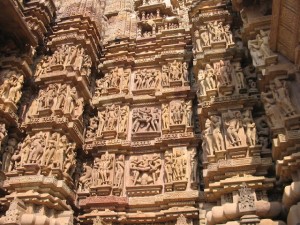 Mahayana sect (which favoured statue-worship) and contain images of the ddha; the remaining two (Caves 1 and 7) are the work of Hinayana monks (who ferred relic-worship) and contain only stupas. They are all vihara monasteries, ept for Cave 10, which is the only chaitya (temple) of the group. Known as the enter Cave (owing to its ceiling ribs, which resemble wooden beams) it contains gigantic Buddha figure, seated in meditation on a lion throne, flanked by attendants flying figures. The image is fronted by a 9-m high stupa. To take any photos in dimly-lit chamber, you’ll need the services of a guide with a mirror. Moving on, Cave 5 is the largest vihara in the group, its title of ‘Assembly Hall’ being suggested by the rows of stone benches within. Cave 12 is a large three-storey enterprise, use.: as a training/sleeping area for student monks. The top floor has eight large Buddha figures, all exceptionally fine, and the walls are carved with attractive reliefs.
Mahayana sect (which favoured statue-worship) and contain images of the ddha; the remaining two (Caves 1 and 7) are the work of Hinayana monks (who ferred relic-worship) and contain only stupas. They are all vihara monasteries, ept for Cave 10, which is the only chaitya (temple) of the group. Known as the enter Cave (owing to its ceiling ribs, which resemble wooden beams) it contains gigantic Buddha figure, seated in meditation on a lion throne, flanked by attendants flying figures. The image is fronted by a 9-m high stupa. To take any photos in dimly-lit chamber, you’ll need the services of a guide with a mirror. Moving on, Cave 5 is the largest vihara in the group, its title of ‘Assembly Hall’ being suggested by the rows of stone benches within. Cave 12 is a large three-storey enterprise, use.: as a training/sleeping area for student monks. The top floor has eight large Buddha figures, all exceptionally fine, and the walls are carved with attractive reliefs.
Cave 16 is the only Hindu example covered on the tour. This is the world-famous Kailash Temple, dedicated to Shiva and built to represent his Himalayan home of Mount Kailash. A stupendous edifice, with dimensions twice the area of the Parthenon in Athens-81 m long by 47 m wide and 33 m high—it was carved from one enormous rock. Unlike all the other caves, which were cut at ground level and took an average of 50 years apiece to fashion, the Kailash was begun from the top of the rock and worked slowly down to the floor—creating gateway, pavilion, courtyard, vestibule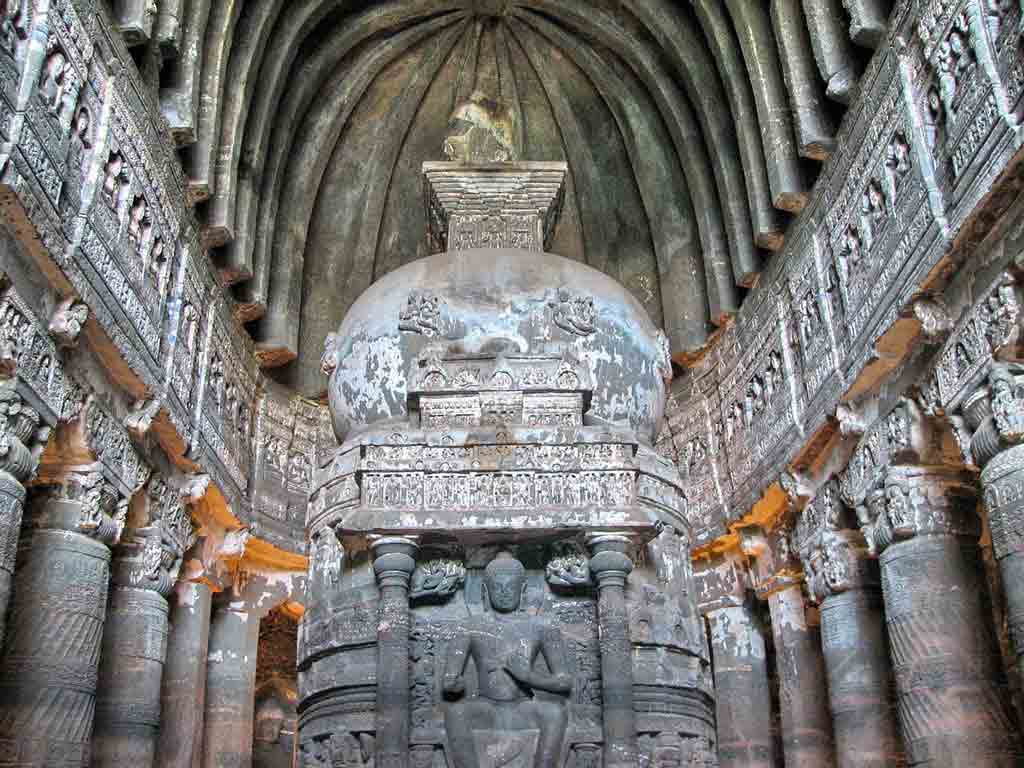 and tower along the way—in an amazing burst of creative energy which, according to one estimate, took 7000 labourers working in continuous shifts 150 years to build. Lavishly carved, and sculptured with epic themes throughout, it is the world’s largest monolithic structure. Attributed to the Rashtrakuta kings of the mid-8th century the temple is a testimony to the skills and imagination of those who built it. Open from 9.30 am to 5.30 pm, admission Rsl (all the other temples are open sunrise to sunset, free admission), the Kailash temple is best viewed during the late-afternoon sun.
and tower along the way—in an amazing burst of creative energy which, according to one estimate, took 7000 labourers working in continuous shifts 150 years to build. Lavishly carved, and sculptured with epic themes throughout, it is the world’s largest monolithic structure. Attributed to the Rashtrakuta kings of the mid-8th century the temple is a testimony to the skills and imagination of those who built it. Open from 9.30 am to 5.30 pm, admission Rsl (all the other temples are open sunrise to sunset, free admission), the Kailash temple is best viewed during the late-afternoon sun.
Entrance to Kailash is via a bridge, leading through an enclosure to a large courtyard. To the front of the enclosure, two large stone elephants (with flagstaffs) flank the Nandi pavilion which faces into the main shrine. Of the many strikingly carved frieze panels, perhaps the most famous is that depicting the demon king Ravana trying to demonstrate his strength by lifting Mount Kailash, while Shiva (unimpressed) puts his foot down to replace it. There are many such episodes from the Rarnayana epic.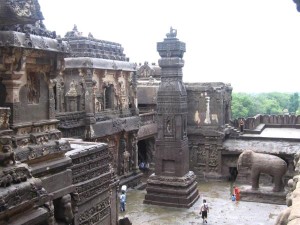
The group of 5 Jain temples (slightly north of the others) mark the final phase of Ellora architecture. They lack the dynamism of the better Hindu caves, but compensate with exceptional attention to detail. You’ll be shown Cave 32, the Assembly Hall of Indra, which is the best of the group. The ground floor is a simple (rather plain) imitation of Kailash, but has exceptional ceiling carvings. The upper storey, reached by a small stairway, is notable for its rich decorations. The shrine contains the seated Mahavira, last of the 24 tirthankars and founder of the Bain religion. The lotus design detail-work on the jain columns is the finest of the whole Ellora complex.
After lunch you’ll visit the small market town of Khuldabad (‘heavenly abode’), 3 km (2 miles) out of Ellora. Once an important centre and fortified village (Aurangzeb built the battlemented wall around it), it remains the Karbala or holy shrine of Deccan Muslims, containing the tombs of many historical figures. Here you’ll visit the simple bare-earth grave of Aurangzeb, last of the great Mughal emperors, surrounded by a decorative marble screen. Renowned for his puritanism, the emperor 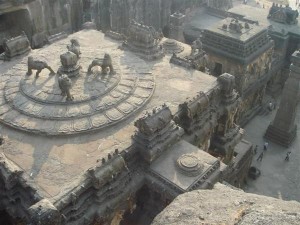 stipulated that only money that he himself had earned by copying out the Koran should be used to pay for his tomb. It was his way, it was said, of atoning for the financial excesses (including the Taj Mahal) of his spendthrift predecessors. Even the screen round his grave was a later addition, donated by the wealthy Hyderabad Nizam.
stipulated that only money that he himself had earned by copying out the Koran should be used to pay for his tomb. It was his way, it was said, of atoning for the financial excesses (including the Taj Mahal) of his spendthrift predecessors. Even the screen round his grave was a later addition, donated by the wealthy Hyderabad Nizam.
Back in Aurangabad, you’ll get a closer look at the Bibi-ka-Maqbara built by Aurangzeb’s son for the emperor’s wife. Popularly known as the ‘poor man’s Taj’, it was erected in 1679—just 25 years after the Taj Mahal itself—and pales in corn-parison. But its low cost of (68 000 rupees-300 times cheaper than the Taj, doubtless mmended it to the parsimonious Aurangzeb. It differs from the Taj in three major pects: the four corner minarets are actually higher than the central mausoleum me; it is built not of marble, but of plaster-covered common stone set on a marble e; finally, the carvings and decorations are far simpler, less ornamental, than those the Taj Mhal.
Last stop is the Panchakki, overlooking Aurangabad’s Kham River. Built in 1624 honour the memory of Baba Shah Musafir, a Sufi saint who was Aurangzeb’s iritual mentor, it is a massive water-wheel which takes its name from a mill which d to supply grain for the masses of visiting pilgrims and holy men. A small dam eases water through the mill-gates into a large fish-filled tank, at the rear of which is a magnificent 500-year-old banyan tree.

